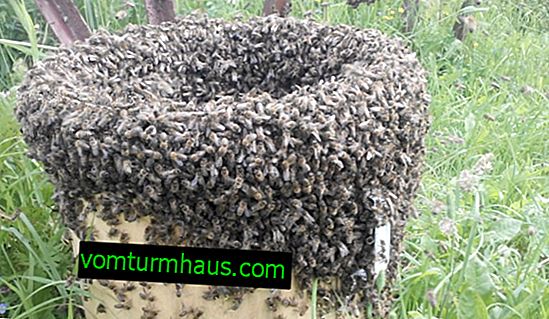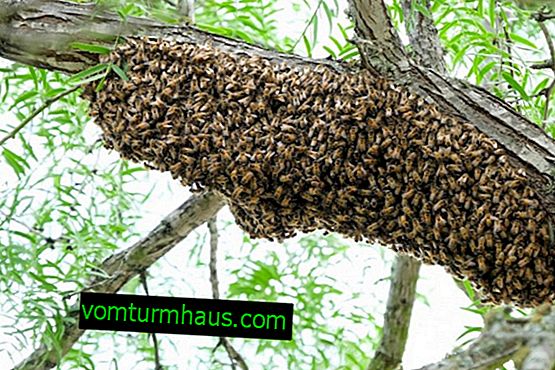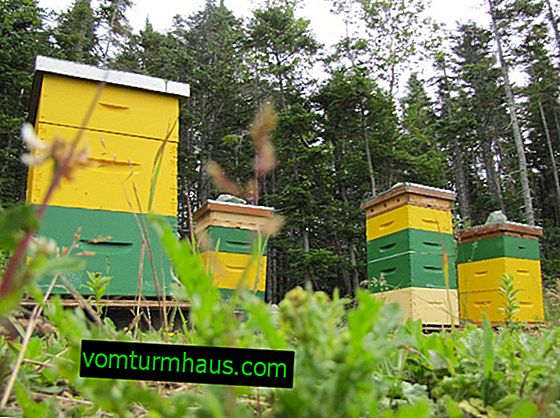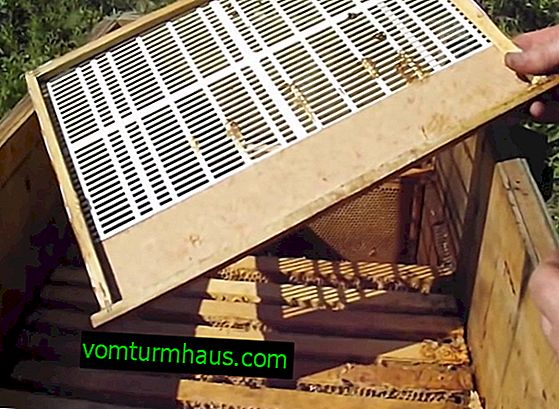Swarm of bees and measures to prevent it
Swarming of bees is a natural process, but it does not always benefit beekeepers, which means that insect instincts should be kept under control. Let's look at the main features of the swarming period, learn about its causes and characteristic signs, and also pay attention to the methods of preventing this process and the methods of catching the swarms that have taken off.
Types of swarms
All insects have their own instincts, many of which are based on the need for procreation. It is on it that the process of swarming in beekeeping is based, but before you figure out how to prevent it, it is worthwhile to understand what types of bee families you may encounter.
Important! In rare cases, the first swarms contain a nonfetal uterus. It appears in the case when the fetal departed with a swarm for some reason cannot fly and it has to be replaced by another, younger one.
Typical swarm species include the following:
- Roy-Pervak - appears after sealing the first mother liquor. It includes the old uterus, which, due to a decrease in egg laying, acquires the ability to fly. Immediately after departure, all flying individuals hover in the air for a while, waiting for the release of the same uterus. It is shown from the hive one of the last, so if you want you can catch it on the arrival board. In full gathering, insects rise into the air and fly over to tree branches or tops of bushes located not far from their former home. In the new area, the bees begin to build new honeycombs and eventually take root there completely.

- Roy is the second. The restoration of the forces of the first swarm is fast enough, largely due to the high rates of egg laying of the uterus before the laying of swarm mother liquors. Young individuals soon emerge from the laid eggs, but already after the departure of the swarm of the pervak. Most often, this group of insects flies out of the hives 9–10 days after the departure of the first batch of insects. Before flying out of its shelter, a uterus that is ripe for this makes characteristic sounds, listening to whether there are any response signals from outside. If there is no other similar individual outside, then it breaks through the lid of the mother liquor and gets out. Then, the appeared uterus bypasses all the honeycombs, making loud peeping sounds, audible even two meters from the hive. In response to them, other uterus also give certain signals, but since they are all sealed in honeycombs, these sounds are more like croaking or grunting. The first uterus may try to destroy the rivals, but the remaining members of the swarm do not allow it to do so, as new individuals may be useful to the family in the future. In such a period, you can hear the characteristic “singing of the queens”, which in the end turns out to be several at once (in this case, the bees can settle not in one, but in two or three places, reproducing offspring).

- Tricks. This variety of swarm should include the third, fourth and all subsequent swarms that came out. They are not as valuable as the first two, since the total weight of the bees is not more than 300-500 g. Such insects do not represent any special value, therefore, in many cases they are mixed with other weak families, removing the unborn queen in advance.

- A swarm of swarms is formed when 2–3 swarms simultaneously departed in one territory at once. They always have several queens, therefore, after the capture of insects, they remain for a long time in increased excitement. When, as a result of the confrontation, only one queen remains in the swarm and one smell appears, all intra-zero disturbances will calm down. Often the formation of dump swarms can be observed after a long period of bad weather, which delays the flight of insects. The total mass of landfill families often reaches 10 kg.

- Swarms of need ("poor"). With all previous families they have only one thing in common - departure from the hive in search of a new place of residence. However, while real swarms are considered an indicator of well-being and fly out for breeding, the "poor" leave their former place with entire families, trying to avoid death. Usually they can be seen either in the early spring or in the autumn period, when the supply of nutrients was exhausted in the hives, so if a swarm has flown up during the non-swarm time, most likely these will be the “poor”.

Unfortunately, even in a prosperous bee family, after several swarms released, very few working individuals remain, which significantly reduces the efficiency of collecting nectar. In addition, swarming can adversely affect the selective work of the beekeeper, largely due to the complicated control of the uterus.
Did you know? To produce 100 g of honey, one bee will have to fly about 1 million flowers. But this is enough only to feed a colony of 1000 larvae, therefore, to create large honey reserves in the family there must be a sufficient number of working individuals.
Signs of swarming
You can prevent the swarming of bees only if you manage to notice it in a timely manner. There are always several signs of this phenomenon:
- active preparation of bowls, in which the laying of eggs is performed (one family can leave behind about 10 queen cells);
- stopping the construction of honeycombs and slowing down (complete cessation) of nectar production;
- the appearance of a large number of drones;
- termination of oviposition, lack of nutrition of the uterus, which makes it very easy and contributes to flight;
- the formation of the so-called "club", from a large number of bees gathering under the hive.

Reasons for swarming
Knowing what a swarm is, it is easy to guess the reasons for its formation. Of course, the main one is the reproduction of new individuals, but not in all cases it is the only one. Other grounds for swarming insects include:
- brood rearing and gathering strength;
- restriction of free space due to the large number of larvae, land and wax delivered to the inside by the beekeeper (the queen has no room for laying eggs);
- insufficient brood for new individuals, which is why they almost immediately go to the construction of wide bowls, thereby provoking the queen to lay more and more eggs (this is how mother liquors are laid);
- a decrease in the intensity of excretion of uterine pheromones, which young individuals can no longer catch (ultimately, this leads to the laying of new mother liquors, usually after the queen is three years old);
- the beginning of a period suitable for breeding (usually the end of May), however, if the bribe is weak (a mixture of bee bread, honey, water and bee glue), then swarming can continue throughout the summer season, which will significantly reduce the honey reserves in the hives.
Swarming Methods
Almost all bees swarm, so avoiding this phenomenon is quite difficult, although not impossible, and this is already pleasing. How to counter this - each beekeeper can decide for himself, because there are always several basic methods to combat the flight of insects.
Consider the main ones:
- Uterus wing trimming is one of the oldest methods to prevent swarm formation. The Queen really cannot fly away from the hive, but this does not mean that the bees will not reject her and will not want to bring out another. This is a significant minus of this method.

- Closing the tap hole . The mesh for the door must be selected so that the working individuals could crawl into the holes, and the uterus could not get out. Without it, the bees will not fly away and will soon return to the hive. The main disadvantage of this method is the possibility of damage to the wings of bees, which is why many individuals die soon. Moreover, the lattice on the letka can only slow down the swarming process, but it is unlikely to stop it in this way (non-fertile uteruses that emerged from the mother cells kill the active queen, but they do not find out the relationship between them). An increase in the number of queens only increases the intensity of swarming, but in the end only one individual is left by the bees, which the beekeepers release from the hive for further mating. After this, the activity of insects for some time decreases, and they remain inactive, which negatively affects the stocks of honey. That is why it is advisable to use this method only for a short time, when for several days there is no way to monitor the movement of the swarm.

- Removing the print brood. This option is suitable for cases where the bees live in 12- and 16-frame hives, consisting of one building. 10-14 days before the main bribe, frames with printed brood are removed from one hive and placed in another, with more weakened insects. An open frame should be installed in place of the seized print brood, which will strengthen the family after the appearance of new bees.

- Change the location of the hives. This method can be used at the stage of laying queen cells and in preparing hives for swarming. The house in which this process takes place needs to be moved to a site with a weakened family, and a beehive with strong inhabitants should be placed in its place. As a result, some of the bees preparing for swarming will fly away, but will soon return to the territory, where they will increase the activity of weak relatives. Having lost part of the composition, the remaining family will weaken and stop swarming, and the mother liquors remain in their places. If they are not damaged by insects, then they are cut out, leaving only a couple to replace the existing uterus (if necessary). When young queens appear, the old one will naturally change, and the main disadvantage of this method is the probability of losing the swarm, it can still leave a new place and fly away in an unknown direction (to change the queen, it is desirable to place a new insect in a separate cage).

- The Demari Method (end of the 19th century). This option provides for the presence of double-hive hives and the possibility of expanding bee nests. In comfortable conditions, the uterus does not stop oviposition, and in order to track its activity, it is enough to place a lattice partition in the lower case. At the bottom of the hive, one frame with the uterus will be placed (on an open brood), and all the remaining ones will occupy the upper part of the house, where the separation grid will be installed. Thus, in the bee house there will be a lot of space for laying wax and sushi, and young individuals and the queen will be separated. Later, the printed brood is taken from the uterus, and only open frames are left, so that swarming is canceled.

- Method Dernova M. A. This option will be appropriate for fully filled mother liquors. Summer individuals need to be moved to an empty hive installed on a site with a swarming family. The main hive needs to be rearranged so that the letok is turned in the opposite direction. Bees will begin to fly into a new house, and the queen cells remaining in the previous hive will be removed by the existing uterus. At the end of the process, the houses are unfolded again (they should stand as before), and the empty hive is removed. Over time, all summer bees will return to the uterus, and the remaining queen bees (except one) must be removed. If the existing queen is weak, the beekeeper destroys her, after which she monitors the appearance of new queens for five days in order to remove them in time and leave only one. The main disadvantage of this method: the bee family does not have time to accumulate strength for the main bribe, since after laying eggs a young uterus has a lot of open brood.
- Method Taranova G. F. It is used for fully filled queen cells, when there is no time to wait for the bees to fly out and you have to create an artificial process. Bees are fumigated with smoke, contributing to a set of full goiter honey. Then, gangplanks are installed on the letka (at a distance of 10-15 cm) and the working bees and uterus are shaken on them. As a result, a kind of insect club is formed under the gangways, from which it is necessary to collect it in a swarm and take it to a dark and slightly cool place for the whole night. On the second day, all the queen cells are removed and the bees are launched into the hive. The disadvantage of this method: the possibility of the formation of new mother liquors with the inaction of the bees. If you leave at least one of them, then the swarm will fly out anyway. For this reason, it is worth sending it to another hive, although in this case the loss of honey reserves is not excluded.
Video: G. Taranova method
Swarm capture methods
If the swarm was not prevented and the bees nevertheless left the hive, then the beekeeper has additional problems associated with catching the fugitives. For these purposes, you can use special traps or do improvised means, which will be discussed later.
Important! Any of the described methods should be used only if the whole bee family is completely healthy, otherwise, when moving insects to other hives, infection of healthy bees is possible.
Trapping
There are ready-made and home-made traps of bee swarms, but in any case, the design will resemble a box with a lid with a volume of at least 50 liters. To increase efficiency, it is desirable to use several such traps at once, placing them in different places of the territory. When making the box yourself, do not forget to cut a hole in it and separate ventilation holes, then place inside the frame with sushi (at least 5-8 pieces) and rub the walls of the structure with the needles, which should attract the attention of insects.

With the right organizational measures, the bees will fall into the trap and, after waiting for the evening, they can be transferred to the hive, after closing all the doors and removing the swarm from the tree. When moving the bees to the hive, make sure that the uterus is also trapped with them, because if this does not happen, you will have to catch the rest of the swarm again.
You will be interested to know where it is better to set traps for bees.
It is better to leave the used trap for some time in the apiary so that the lagging individuals can be found already resettled. At the end of the capture, it remains only to clean this structure and prepare for further use.
Trapping without traps
In the absence of a special war for the capture of flying bees, you can use the lower part of the Dadanov hive or a sunbed located at a distance of 50 m from the apiary. Inside the chosen design, 8 frames with sushi are placed and, as in the previous case, the walls of the needles are rubbed to attract insects. The main advantage of this option is that there is no need for further relocation of the captured insects, because inside the used structure all the conditions for the full development of the bee family are already created.

After some time, the insects gather in a box, and it is important not to panic: when swarming, they do not bite, the main thing is not to perform sudden movements. As soon as you feel that the box is getting heavier, slow down even further to collect the maximum number of bees. The main task is to lure the uterus inside, which should be followed by all other individuals. Gathering insects, carefully remove the box and move it to a tree branch or stand, but only so as to exclude the possibility of ants getting inside.
We recommend that you learn how to make a framework for bee hives.
Cover the bees with a cloth and leave for a while to calm them down. With the arrival of the evening, it remains only to resettle them in a free hive or add them to a weak bee family. The hardest thing is to remove the swarm, which is located at the very top of the tree. You can’t do without a ladder and a suitable trap here, and to calm insects a bit, take a spray bottle with clean water (it's easier to assemble them).

Did you know? Каждая пчелиная особь живёт не больше 40 суток, но лишь под конец своей жизни начинает добывать мёд. Вначале все молодые насекомые чистят ячейки для новых яиц и следят за проветриванием улья.
Теперь вы знаете, что делать, когда пчёлы роятся и покидают ульи, а чтобы не допустить этого, можно использовать один из вышеприведённых методов. Если вы не хотите лазить по деревьям с ловушкой в руках, тогда это станет отличным стимулом для применения любого из них.













